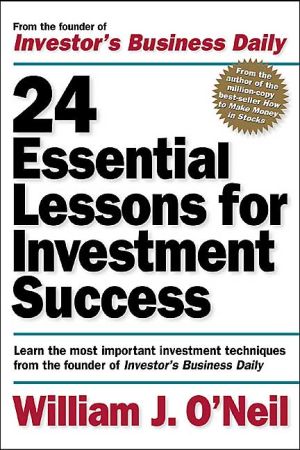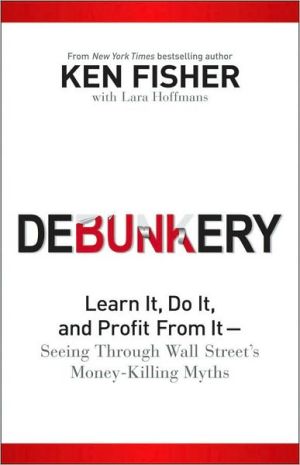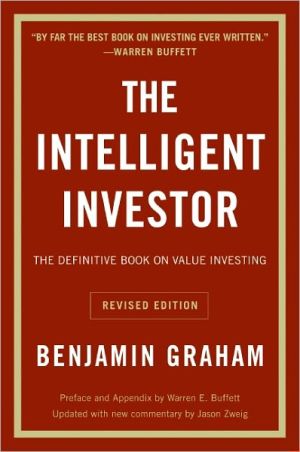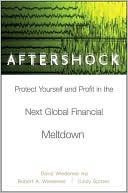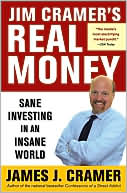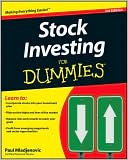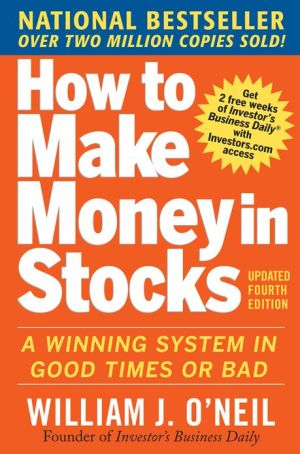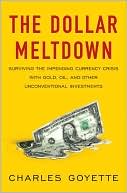24 Essential Lessons for Investment Success: Learn the Most Important Investment Techniques from the Founder of Investor's Business Daily
The Wall Street Journal, New York Times, BusinessWeek, and USA Today Business Bestseller!\ From the publisher of Investor's Business Daily and best-selling author of How to Make Money in Stocks, comes the National Bestseller, 24 Essential Lessons for Investment Success, two dozen of the most important lessons for investors. In this one accessible guide, William J. O'Neil puts his popular and easy-to-follow techniques for building a profitable portfolio firmaly in the hands of...
Search in google:
One of the world's leading investment advisers offers uniqueinvesting do's and don'ts that help you multiply your money.Drawing from his highly popular "26 Weeks to Investment Success" series in Investor's Business Daily, chairman and founder William J. O'Neil gives you a bounty of proven, easy-to-apply techniques for building a profitable portfolio. O'Neil cuts through the static of conventional "wisdom" with a refreshing array of common-sense strategies that help you accurately gauge the market . . . buy and sell stocks at just the right moment . . . seize opportunities presented by market corrections . . . take advantage of the rich potential of mutual funds . . . and successfully manage your portfolio. Essential reading for investors of all levels, this eye-opening guide to solid investment practices now puts the goal of long-term financial security easily within your reach.Praise for O'Neil's 24 Essential Lessons for Investment Success:"When it comes to investment and stock selection, you couldn't get a better mentor than Bill O'Neil. . . . A must read for the serious do-it-yourself investor." Harry S. Dent, Jr., author, The Roaring 2000s and The Roaring 2000s Investor"There simply isn't any other book that can be called a handbook for Cramer, Berkowitz." Jim Cramer, Co-founder, TheStreet.Com & Hedge Fund Manager, Cramer, Berkowitz & Co."No fad can compete for long with the sound principles that William O'Neil shares with investors. In my 35 years in the business, I've found very few folks who really know the market, how to pick good stocks over time, and when to sell better than Bill."Foster Friess, Chairman, Friess Associates and Co-Manager, Brandywine Funds"In this era of information overload, day trading, and market volatility, author Bill O'Neil takes the emotion out of investing and lays out a clear, understandable road map on long-term investing."Linda O'Bryon, Senior Vice President and Executive Editor, Nightly Business ReportWilliam J. O'Neil is the founder and Chairman of Investor's Business Daily, one of the leading financial newspapers in the world and the author of the million-copy bestseller, How to Make Money in Stocks. He has a long and successful track record as an analyst and investor, is the creator of the CANSLIM charts, and is recognized as a leading advisor to individual investors around the world. USA Today A logical road map to investing...that should serve you well.
Lesson 1: What Every Investor Should Know Going In\ Before founding Investor's Business Daily in 1984, Bill ONeil already had 25 years of experience in the market as an individual investor, stock broker, investment adviser, and owner of a securities brokerage and research firm that today counts nearly every major institutional investor as a client. His career started at age 22, just after he graduated from Southern Methodist University, got married, joined the Air Force and became interested in his financial future. He bought his first stock with $500-all he had at the time. He also started reading books on the market. According to Bill ONeil, the best was Gerald Loeb's Battle for Investment Survival. It's there we pick up our conversation.\ What is the single most important thing an investor should know?\ Loeb was a highly successful investor and preached cutting all your losses short. And for me, this is rule #I. You must always protect your investment account. Particularly if you invest on margin (use borrowed money), cutting losses is absolutely essential.\ Whether you're a new or experienced investor, the hardest lesson to learn is that you're simply not going to be right all the time. And if you don't cut every loss quickly, sooner or later you'll suffer some very large losses. I've known seven highly intelligent, educated men in their 40s who were wiped out because they invested on margin and had no sell discipline. Brains, education, ego, stubbornness and pride are deadly substitutes for having and following sound selling rules.\ The problem is, you always hope to make money when you buy a stock. And when you have to sell and take a loss, you find itgut-wrenching and hard to admit you were wrong. You'd rather wait and hope the price will come back.\ To make matters worse, when you do try to cut losses, half the time the stock will turn around and go back up in price. Then you're really upset. You conclude you were wrong for selling and that the loss-cutting policy is a bad one.\ How you think about losses is critical. Historically, this is where most investors go wrong and get confused.\ Ask yourself the following: Did you buy fire insurance on your house last year? Did your house burn down? If it didn't, were you upset because you wasted your money on the insurance? Will you refuse to buy fire insurance next year? Why do you buy fire insurance in the first place, because you know your home is going to burn down?\ No! You buy insurance to protect yourself against the remote possibility you could suffer a major loss that would be difficult to recover from. That's all you do when you cut short your losses.\ How do you define short?\ For Loeb, it was 10%, which is probably a good rule for most beginning investors. But when you use charts to time your purchases more accurately, I recommend cutting all losses at 7% or 8% below your purchase price. By doing this, you're taking out little insurance policies to protect yourself from possible substantial losses.\ If you let a stock go down 50% from where you bought it, you must make 100% on the next stock just to break even. Now, how often do you buy stocks that double in price?\ How long did it take you to become successful investing?\ It took me two to three years to figure out how to put the whole system together. It doesn't happen overnight. For most people the learning curve is about the same. As the years go by, you should get better and better at stock selection, and the number of individual 7% or 8% losses should drop significantly. Plus, these small losses will be offset by much larger profits from your big winners.\ Think of a number of controlled losses as your tuition to Wall Street. Most people think that investing in a college degree is a sound decision. They don't think of it as a waste of money because they have hopes of having that degree pay off in future success. Why should success in the stock market be any different?\ Anything worth succeeding at takes time to learn. Professional ballplayers aren't made in three months and neither are successful investors. The only difference between the successful person and everyone else is determination and persistence.\ How persistent have you had to be at times?\ I once had a string of ten stocks that I cut losses on. But the very next one emerged just as the market came out of a correction (downtrend) and more than tripled in price. I've often thought: "What would have happened if I had gotten discouraged and quit because the previous ten stocks I bought didn't work?"\ The tricky part is getting rid of the emotion attached to making decisions, like cutting losses. It doesn't feel comfortable to sell something you may have purchased only a few weeks ago because it's now down 8% below your cost. Emotions take over. We try to defend our original decision to buy and justify holding the stock even though we're now in the negative.\ But you can't go through life looking in the rear-view mirror. You can get yourself in a lot of trouble with the "could'ves," "would'ves" and "should'ves."\ When you bought the stock, that was last week or last month-not today. Today is a whole different situation, and you've got to protect yourself from serious losses-which could happen to anyone-so you can still invest tomorrow.\ Why did you pick 8% as the rule?\ If you cut your losses at 8%, it will always allow you to survive to invest another day. I've seen people go bankrupt or ruin their health because they'd fall in love with a stock, couldn't face up to and admit mistakes, and couldn't make the hard sell decisions. Vacillating when it comes time to sell is how you will sooner or later experience big losses. And big losses will cause you to lose your confidence, which you absolutely cannot let happen if you expect to continue investing.\ If you're worried, the old adage, "sell down to the sleeping point," is the best way to relieve some pressure. You don't have to sell it all, just sell something so you can sleep at night.\ If you cut all your losses at 7% or 8% below your purchase price, and then sell just a few of your stocks when you're up 25% to 30%, you can be right once and wrong twice and still not get into trouble.\ Your best-performing stocks should be held longer for a larger possible profit. Always sell your worst-performing stock first, not your bestperforming stock.\ What is the risk in any stock?\ Under the method that I've laid out, your risk in any one stock is always limited to 8%, whether you're buying AT&T or the leading internet stock...
Preface. Acknowledgements. 24 Essential Lessons for Investment Success. Lesson 1: What Every Investor Should Know Going in. Lesson 2: Getting Started: There's No Time Like the Present! Lesson 3: Follow a System Rather Than your Emotions. Lesson 4: Fundamental Analysis or Technical Analysis? Lesson 5: First Among Fundamentals: Earnings and Sales. Lesson 6: Relative Price Strength: A Key Technical Tool. Lesson 7: Know a Stock by the Company It Keeps. Lesson 8: The Importance of Volume and Sponsorship. Lesson 9: How to Buy at Just the Right Moment. Lesson 10: How Chart Patterns Lead to Big Profits. Lesson 11: How to Read Stock Charts Like a Pro. Lesson 12: How to Gauge the Stock Market's Health. Lesson 13: How to Spot When the Market Hits a Top. Lesson 14: How to Spot When the Market Bottoms. Lesson 15: Putting the Stock-Picking Puzzle Together. Lesson 16: how to Find New Investment Ideas in Investor's Business Daily. Lesson 17: Growth vs. Value investing. Lesson 18: Don't Try to Be a Jack-of-all-Trades. Lesson 19: What's the Right Mix for Your Portfolio? Lesson 20: Sell Rules Every Investor Should Master. Lesson 21: More Sell Rules Every Investor Should Master. Lesson 22: How to Make a Million with Mutuals. Lesson 23: Too Busy? How to Use Investor's Business Daily in Twenty Minutes. Lesson 24: How to Make the Most of Investor's Business Daily, Investors.com, and Other Online Resources. Appendix A. Appendix B. Recommended Reading List. Glossary. Index.
\ USA TodayA logical road map to investing...that should serve you well.\ \
